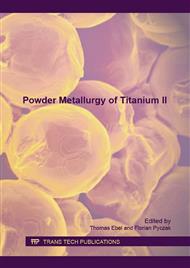[1]
U.M. Attia, J.R. Alcock, A Review of Micro-Powder Injection Moulding as a Microfabrication Technique, J. Micromech. Microeng. 21 (4) (2011).
DOI: 10.1088/0960-1317/21/4/043001
Google Scholar
[2]
D. Erath, A. Filipovic, M. Retzlaff, Advanced screen printing technique for high definition front side metallization of crystalline silicon solar cells, Solar Energy Materials & Solar Cells 94 (2010), 57-61.
DOI: 10.1016/j.solmat.2009.05.018
Google Scholar
[3]
S. Ito, P. Chen, P. Comte, Fabrication of Screen-Printing Pastes From TiO2 Powders for Dye-Sensitised Solar Cells, Prog. Photovolt: Res. Appl. 15 (2007), 603-612.
DOI: 10.1002/pip.768
Google Scholar
[4]
O. M. Ferri, T. Ebel and R. Bormann, The Influence of a Small Boron Addition on the Microstructure and Mechanical Properties of Ti-6Al-4V Fabricated by Metal Injection Moulding, Advanced Engineering Materials 13 (5) (2011) 436-447.
DOI: 10.1002/adem.201000280
Google Scholar
[5]
T. Ebel, O. Milagres Ferri, et al., Metal Injection Moulding of Titanium and Titanium-Alluminides, Key Eng. Mater. 520 (2012) 153-160.
DOI: 10.4028/www.scientific.net/kem.520.153
Google Scholar
[6]
J. H. Luan, Z. B. Jiao et al., Journal of Alloys and Compounds 602 (2014) 235-240.
Google Scholar
[7]
T. Ebel, Advances in the Metal Injection Moulding of Titanium at Euro PM2014, PIM International 9 (1) (2015) 51-61.
Google Scholar
[8]
Y. F. Yang, S. D. Luo et al., Impurity Scavenging, Microstructural Refinement and Mechanical Properties of Powder Metallurgy Titanium and Titanium Alloys by a small addition of Cerium Silicide, Mater. Sci. Eng. A 573 (2013) 166-174.
DOI: 10.1016/j.msea.2013.02.042
Google Scholar
[9]
B. Poorganji, A. Kazahari et al., Effect of Yttrium Addition on Grain Growth of α, β and α+β Titanium Alloys, IOP Publishing, Journal of Physics: Conference Series 240 (2010).
DOI: 10.1088/1742-6596/240/1/012170
Google Scholar
[10]
V. de Castro, T. Leguey et al., Microstructural and Tensile Properties of Y2O3-dispersed Titanium produced by Arc Melting, Mater. Sci. Eng. A 422 (2006) 189-197.
DOI: 10.1016/j.msea.2006.02.027
Google Scholar
[11]
R. M. German, Progress in Titanium Metal Powder Injection Moulding, Materials 6 (2013) 3641-3662.
DOI: 10.3390/ma6083641
Google Scholar
[12]
J. J. Qazi, O. N. Senkov, et al., Kinetics of Martensite Decomposition in Ti-6Al-4V-xH Alloys, Mater. Sci. Eng. A 359 (2003) 137-149.
DOI: 10.1016/s0921-5093(03)00350-2
Google Scholar
[13]
J. D. Paramore, Z. Z. Fang et al., A Powder Metallurgy Method for Manufacturing Ti-6Al-4V with Wrought-like Microstructures and Mechanical Properties via Hydrogen Sintering and Phase Transformation (HSPT), Scripta Mater. 107 (2015) 103-106.
DOI: 10.1016/j.scriptamat.2015.05.032
Google Scholar
[14]
D. H. Kohn, P. Ducheyne, Microstructural Refinement of β-sintered and Ti-6Al-4V Porous-coated by Temporary Alloying with Hydrogen, J. Mater. Sci. 26 (1991) 534-544.
DOI: 10.1007/bf00576555
Google Scholar
[15]
C. -C. Shen,C. -M. Wang, Effect of Hydrogen Loading and Type of Titanium Hydride on Grain Refinement and Mechanical Properties of Ti-6Al-4V, J. Alloys Compd. 601 (2014) 274-279.
DOI: 10.1016/j.jallcom.2014.02.171
Google Scholar
[16]
D. Eliezer, N. Eliaz et al., Positive Effects of Hydrogen in Metals, Mater. Sci. Eng. A 280 (2000) 220-224.
Google Scholar
[17]
Z. Z. Fang, P. Sun, Hydrogen Sintering of Titanium to Produce High Density Fine Grain Titanium Alloys, Adv. Eng. Mater. 14 (2012) 383-397.
DOI: 10.1002/adem.201100269
Google Scholar
[18]
P. Sun, Z. Z. Fang et al., An Experimental Study of the (Ti-6Al-4V)-xH Phase Diagram Using In Situ Synchrotron XRD and TGA/DSC Techniques, Acta Mater. 84 (2014) 29-41.
DOI: 10.1016/j.actamat.2014.10.045
Google Scholar
[19]
J. I. Qazi, J. Rahim et al., Phase Transformations in the Ti–6Al–4V–H System, Journal of Metals, 54 (2002) 68–71.
DOI: 10.1007/bf02701081
Google Scholar
[20]
M. Peters, C. Leyens, Titan und Titanlegierungen, Wiley-VCH, Weinheim, (2002).
Google Scholar
[21]
E. Baril, L.P. Lefebvre and Y. Thomas, Interstitial Elements in Titanium Powder Metallurgy: Sources and Control, Powd. Metall. 54 (2011) 183-187.
DOI: 10.1179/174329011x13045076771759
Google Scholar
[22]
Standard Specification for Metal Injection Molded Titanium-6Aluminum-4Vanadium Components for Surgical Implant Applications, Annual Book of ASTM Standards Standard F2885-11 (2011).
DOI: 10.1520/f2885-11
Google Scholar


